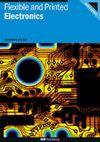用组合喷墨印刷评价多噻吩作为感温材料
IF 3.2
4区 工程技术
Q3 MATERIALS SCIENCE, MULTIDISCIPLINARY
引用次数: 2
摘要
聚噻吩是一类新兴材料,在温度传感领域具有潜在的应用前景。在本文中,我们验证并应用集成的共混和印刷方法来组合研究聚噻吩PEDOT:PSS和P(S-EDOT)(一种类似PEDOT的自掺杂共轭聚合物)的原始和成分梯度共混物的库,以了解它们的固有导电行为及其对共混物组成和环境温度的温度依赖性。进行假设测试是为了从输入材料比例的组合中确定电导率的最佳值,以满足在任何单组分溶液可加工材料中难以实现的多种要求。我们选择PEDOT:PSS作为商业开发的本质导电聚噻吩,并与之比较了一种新型自掺杂聚噻吩P(S-EDOT)作为传感器材料的潜在替代或补充。研究了两种聚合物及其共混物作为温度传感应用的不同组分的电学和形态特征。考虑了工艺流程中的不同误差源,得出了关于不同成分对温度传感不同方面的效用的具有统计学意义的结论。本文章由计算机程序翻译,如有差异,请以英文原文为准。
Evaluating polythiophenes as temperature sensing materials using combinatorial inkjet printing
Polythiophenes comprise a class of emerging materials with potential applications in the field of temperature sensing. In this article, we validate and apply an integrated blending and printing methodology to combinatorially study libraries of pristine and compositionally graded blends of polythiophenes PEDOT:PSS and P(S-EDOT) (a PEDOT-like self-doped conjugated polymer) to understand their intrinsic electrical conductivity behaviour and along with its temperature dependence on blend composition and ambient temperature. Hypothesis testing is conducted to identify optima in electrical conductivity from combinations of input material proportions intended to meet multiple requirements otherwise difficult to achieve in any single-component solution-processable material. We chose PEDOT:PSS as a commercial developed intrinsically conductive polythiophene and with it, compared a novel self-doped polythiophene P(S-EDOT) as its potential replacement or complement as a sensor material. The electrical and morphological characteristics for both polymers and their blends were investigated for use as different components of temperature sensing applications. Different error sources within the process flow were considered for statistically significant conclusions regarding the utility of different compositions for different aspects of temperature sensing.
求助全文
通过发布文献求助,成功后即可免费获取论文全文。
去求助
来源期刊

Flexible and Printed Electronics
MATERIALS SCIENCE, MULTIDISCIPLINARY-
CiteScore
4.80
自引率
9.70%
发文量
101
期刊介绍:
Flexible and Printed Electronics is a multidisciplinary journal publishing cutting edge research articles on electronics that can be either flexible, plastic, stretchable, conformable or printed. Research related to electronic materials, manufacturing techniques, components or systems which meets any one (or more) of the above criteria is suitable for publication in the journal. Subjects included in the journal range from flexible materials and printing techniques, design or modelling of electrical systems and components, advanced fabrication methods and bioelectronics, to the properties of devices and end user applications.
 求助内容:
求助内容: 应助结果提醒方式:
应助结果提醒方式:


